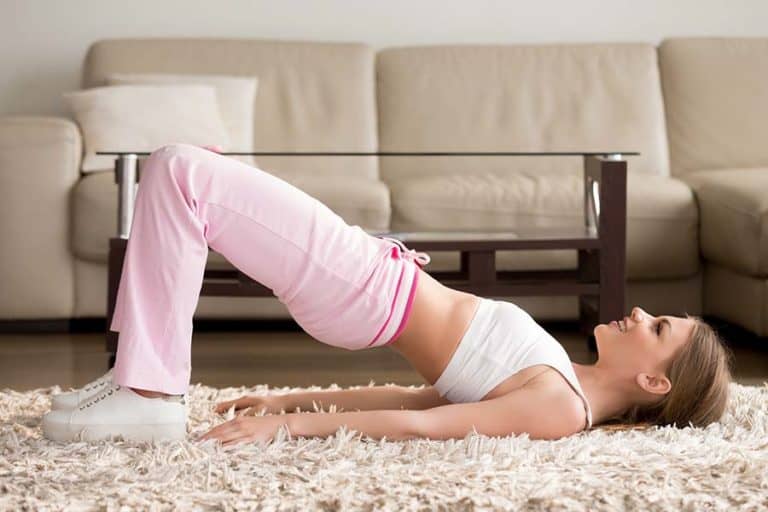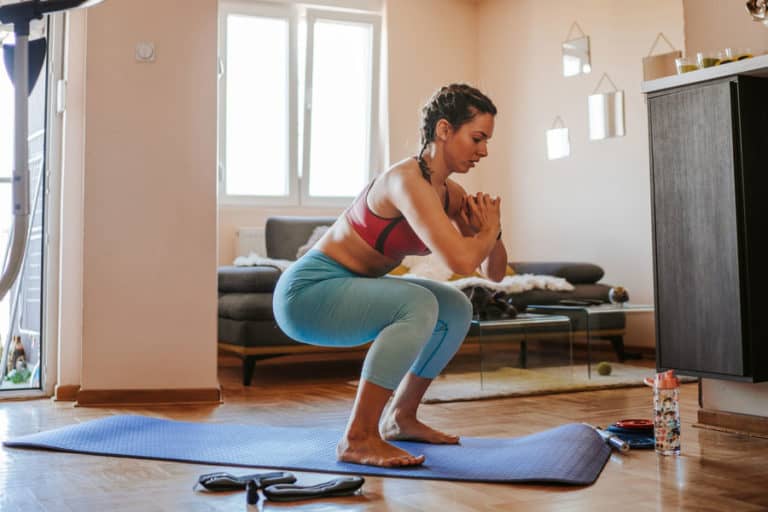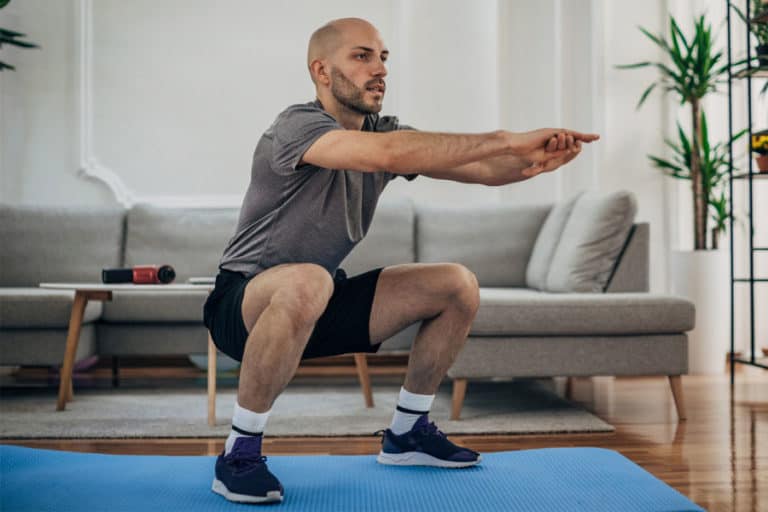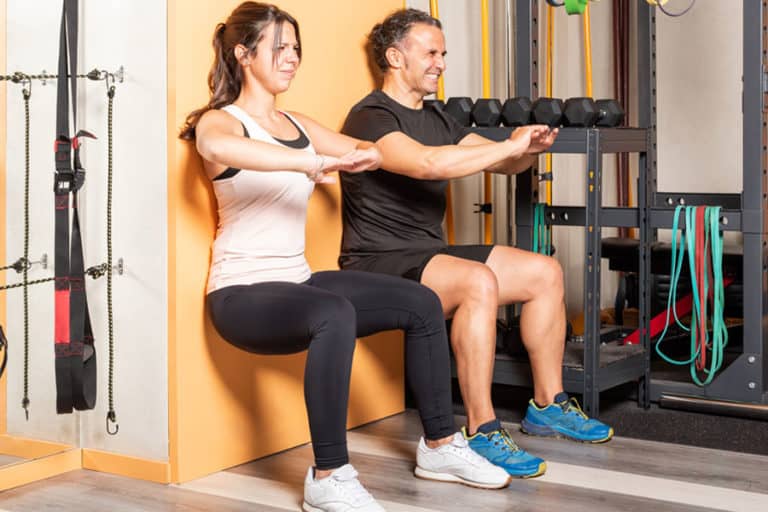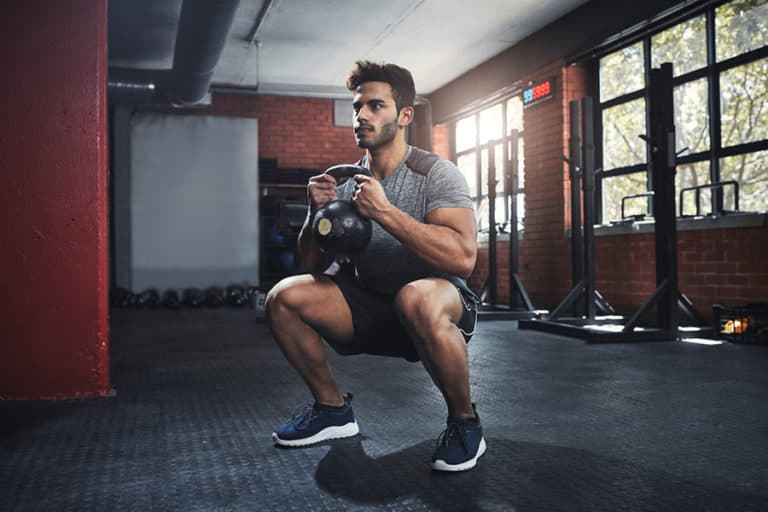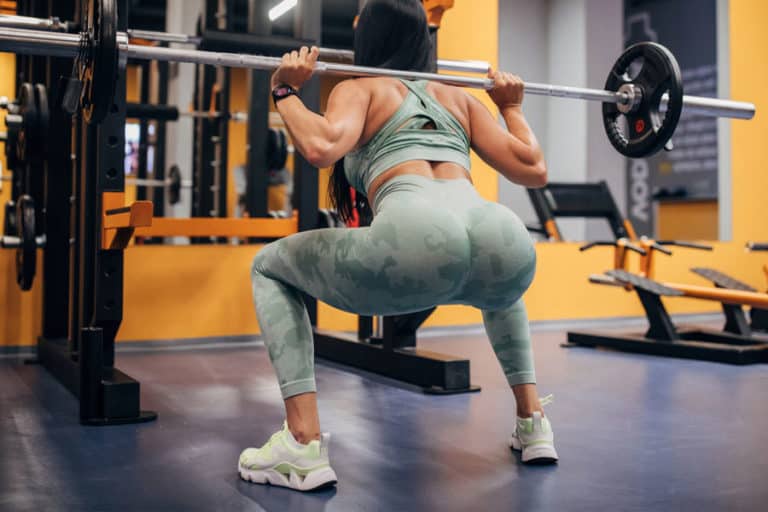Back Squat – How to do, Variations, And Safety Tips
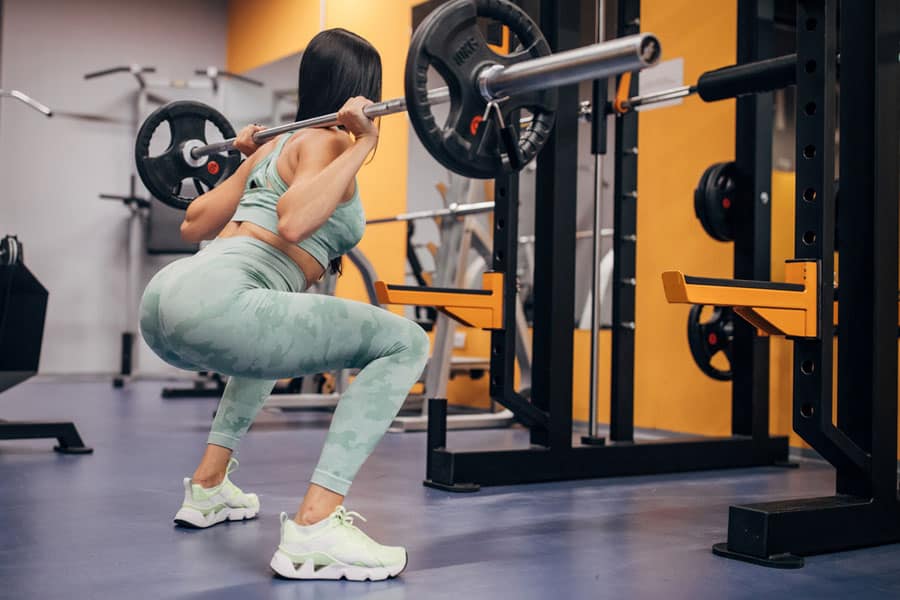
How to do | Muscles worked | Who Should/Should Not | Add to routine | Safety Tips | Benefits | Variations | Alternatives
The back squat is a fundamental strength and muscle-building exercise that should be a staple in any workout routine. Though it might seem like a simple move, it is a complex exercise. Unlike other squats, this squat type works a variety of muscle groups and can be performed with many different variations.
How to do a back squat?
Back squats can be performed in more than one style. While powerlifters rely on a low-bar squat, a high-bar squat is the standard technique you can add to your workout routine.
Here is a detailed step-by-step guide on how to do a standard barbell back squat with the correct form.
- Start by standing in front of a barbell placed on a squat rack.
- Adjust the barbell to your shoulder height and load it with the desired weight.
- Stand under the bar keeping your feet shoulder-width apart.
- Grip the bar with your hands placed outside your shoulders.
- Bend at the knees, straighten your back and prepare yourself to take the weight off the rack.
- Push through your legs, keeping your back straight, and take the weight off the rack.
- Place the barbell on your shoulders without stressing the back of your neck.
- Step back from the rack along with the barbell.
- Push your hips back, bend your knees and squat down until your thighs are parallel to the floor.
- Slowly drive through your heels to go back to the standing position.
Muscles worked
As a compound exercise, the back squat targets all major lower body muscles and stabilizes the core and upper body.
Here are the muscles targeted in a back squat.
Primary muscles worked
| Quadriceps | rectus femoris, vastus lateralis, vastus medialis, vastus intermedius |
| Gluteal muscles | gluteus maximus, gluteus medius and glutes minimus |
| Adductor muscles | adductor brevis, adductor longus, adductor magnus, pectineus and gracilis |
Secondary muscles worked
| Core trunk muscles | rectus abdominis, transverse abdominis, internal and external obliques |
| Calves | gastrocnemius and soleus |
| Hamstrings | biceps femoris, vastus intermedius, vastus lateralis, and vastus medialis |
| Erector spinae | iliocostalis, longissimus and spinalis |
| Shoulder muscles | traps, pectoralis, deltoids, and serratus anterior |
Who should and should not do back squats?
Once you master a basic bodyweight squat and dumbbell squat, you can try a back squat. However, this squat movement pattern is ideal for a few and not recommended for others.
Who should do a back squat?
- Back squat is recommended for powerlifters, athletes [1]National Library of Medicine: The back squat: A proposed assessment of functional deficits and technical factors that limit performance, weightlifters, and bodybuilders as it builds muscles and strength.
- Individuals who are looking to target multiple muscle groups in one movement can perform back squat.
- This squat type is also recommended for people who want to build endurance and mobility.
Who should avoid back squats?
- If you have a herniated disc or a knee, hip, or lower back injury, it is best to avoid a back squat until your recovery.
- People who are new to squatting or have not perfected their squat form should also refrain from doing back squats.
Adding to your routine
Back squats are easy to incorporate into your fitness routine. You can include them in your leg day workout depending on your fitness level and goals. Here is how you can add this incredible squat variation.
Stand-alone back squat workout routine based on goals:
| Goal | Sets*Reps |
| Beginner | 3-4 sets of 8-10 reps with light weight |
| Build muscle | 4-5 sets of 6-8 reps with moderately heavy weight |
| Gain strength | 6-8 sets of 3-5 reps with heavy weight |
Beginner level
Here is a sample workout plan for beginners to add back squat into your routine.
| Beginner Level Exercises | Reps |
| Warmup (Spot jogging/jumping jacks) | 3-5 Minutes |
| Air Squat | 2-3 sets of 6-8 reps |
| Pause squat | 2-3 sets of 8-12 reps |
| Goblet squat | 2-3 sets of 8-10 reps |
| Back squat | 2-3 sets 8-10 reps |
Intermediate/Advanced Level
Here is a sample workout plan for intermediate or an advanced fitness enthusiast to add back squat into your routine.
| Intermediate/Advanced Level Exercises | Reps |
| Warmup (Spot jogging/jumping jacks) | 3-5 Minutes |
| Pistol squat | 3-5 sets of 10-12 reps |
| Lying leg curls | 4-6 sets of 10-15 reps |
| Back squat | 3-5 sets of 12-15 reps |
| Leg press | 3-4 sets of 10-15 reps |
Safety tips for doing back squats correctly
The back squat is a safe exercise, but the complexity of the movement can make it intimidating to some. However, with proper form and practice, you can master this exercise.
Here are some safety tips for doing a back squat correctly.
1. Don’t lean forward
Leaning forward is a common tendency when squatting deep. This could be a sign of weak glutes or tight hip flexors. Keep your core tight and focus on squatting with a neutral spine.
2. Go as low as you can
Back squat requires a lot of mobility in the hips and ankles. If you can’t squat low enough, work on your mobility first.
However, don’t do ego-squatting to the extent that your body starts aching. Listen to your body and go as low as possible without compromising your form.
3. Always look up
When squatting, resist the urge to lower your head. Instead, focus on looking up. When you look down, your back automatically tends to round. Looking up will help you maintain a neutral spine.
4. Push from the heels
When you squat, make sure to push from your heels and not your toes. This will help you avoid unnecessary stress on your joints and tendons.
Note: If you are squatting correctly, you should not feel pain in your lower back. Lower back pain is usually a sign that you are not using the correct form and/or your core is weak.
Benefits of doing back squats
Adding back squats to your workout routine has a lot of benefits.
1. Improves leg strength
The back squat engages all the major muscles in your legs. This makes it an excellent choice to increase your leg strength and build the muscles of the legs [2]National Library of Medicine: Maximizing Muscle Hypertrophy: A Systematic Review of Advanced Resistance Training Techniques and Methods. Eventually, it prepares your body for more advanced and intense physical training activities.
2. Increases lower body strength
The back squat involves a deep knee bend, which strengthens the multiple muscle groups in the lower body.
3. Enhances posture
Back squats help improve posture by activating the upper back and lower body muscles. They open up your hips and engage your upper back and shoulders, which helps to keep your spine in a neutral position.
This is important for preventing injuries and promoting optimal position (posture).
4. Burns calories
When done with proper form and intensity, back squats help in burning a good number of calories. This makes it an excellent choice for people who are looking to lose weight.
Back squat variations
You can include plenty of back squat variations in your workout routine to advance your lower body strength training.
Low bar squat
Low bar squat is the most common variation of the back squat. The difference between a standard back squat and a low bar back squat is in the placement of the bar. In low bar squats, the bar is placed on your upper back and rear deltoids (shoulder blades).
Tempo back squat
Tempo back squat is a great way to improve your squat form and increase angular strength.
This variation includes a time count for different phases of the exercise – lowering (eccentric phase), pausing, and lifting (concentric phase).
A typical tempo back squat would be 2 to 4, for example, you would take four seconds to lower your body, pause for 0 seconds and take two seconds to get back up.
Back squat alternatives
If you want to try back squat alternatives, here is a list of exercises you can try.
1. Front squat
Research [3]PubMed: A biomechanical comparison of back and front squats in healthy trained individuals on biomechanical comparison of back and front squats suggests that the front squat is as effective as the back squat with regard to overall muscle recruitment.
2. Pause squats
The pause squat is identical to the back squat in terms of the range of motion and muscle recruitment.
The only difference is that you pause for 1-2 seconds in the bottom position before coming back up.
It is a great exercise to develop isometric strength and improve your hip and ankle mobility.
3. Overhead squat
The overhead squat is more challenging than the back squat as they require you to keep the barbell overhead throughout the movement.
It is important to have good mobility and stability before trying this variation.
4. Hack squat
The hack squat is a machine-based exercise that targets the same muscle groups as the back squat. This exercise is an excellent alternative for those who want to avoid loading their spine with a barbell.
Conclusion
Back squat is an effective full-body exercise. However, to reap all the benefits of this versatile exercise, you need to master it with proper form. Once you nail the form, advance it by adding more weights gradually. Consult a certified trainer before progressing with this exercise.
References
| ↑1 | National Library of Medicine: The back squat: A proposed assessment of functional deficits and technical factors that limit performance |
|---|---|
| ↑2 | National Library of Medicine: Maximizing Muscle Hypertrophy: A Systematic Review of Advanced Resistance Training Techniques and Methods |
| ↑3 | PubMed: A biomechanical comparison of back and front squats in healthy trained individuals |


